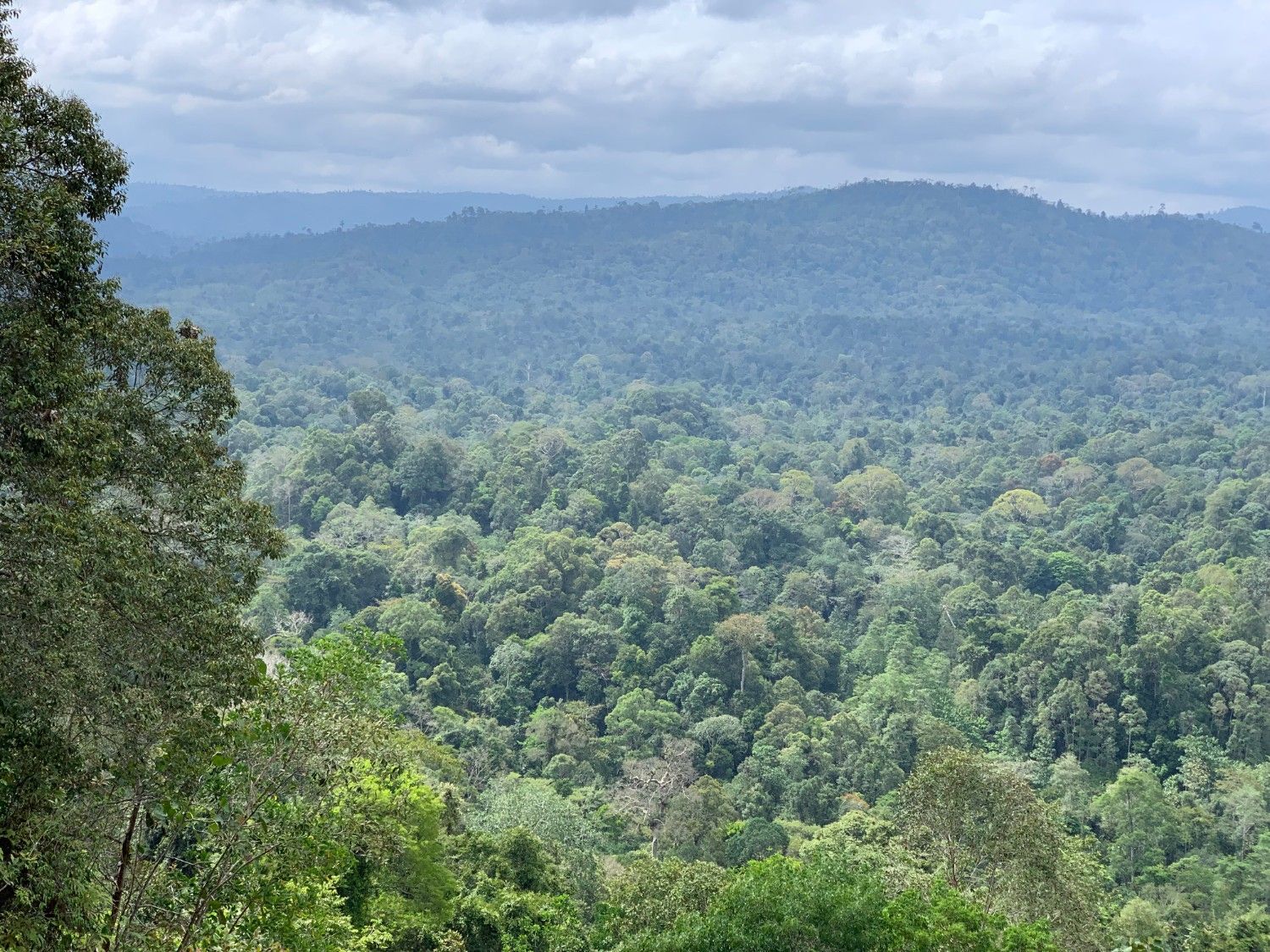Many years ago I saw a TED talk by Willie Smits telling the story of How to restore a rainforest on severely degraded land in Borneo. The forest became a sanctuary for orangutans and the home for thousands of people who found employment in harmony with nature. They changed the local climate and became the supply of fresh water for many people. When I saw this talk for the first time I thought “there is hope, we can revert the damage”. It was 2009 and it didn’t cross my mind that exactly 10 years later I would be visiting Willie in his evolved version of the restoration model looking to learn and collaborate.
After half an hour boat ride from Balikpapan in Borneo we arrived at the site of the ARSARI Environmental Industries. A few years back, an Indonesian businessman, that Willie knew through his support for animal conservation, bought a logging concession of almost two hundred thousand hectares in what was previously a large scale logging operation. The enormous fires of 1998 destroyed 70% of the forest, an area roughly 14 times the size of inner Paris! Now in the hands of a world leading conservationist with the backup of a powerful business group supporting his vision the story has dramatically changed.
ARSARI is now cutting the secondary forest that grew after the logging disaster. This forest is composed mainly of pioneer species—species that grow after a forest is cut—that are now decaying because they are at the end of their biological life, therefore releasing CO2 back into the atmosphere. The group is harvesting the dying wood and turns it into biochar and biocoal, a stable and inert form of carbon that looks like common charcoal but is profoundly different. When the biochar is mixed with compost and integrated into the soil it sequesters CO2 for thousands of years. Biochar becomes a host for a complex community of microorganisms and fungi that enhance the fertility of the soil, retains nutrients, retains water in the soil, builds organic matter, lowers the acidity of the soil and filters out toxins. Biochar can also be fed to cows to lower methane emissions.
On top of all these amazing qualities, the biochar miracle is not over. Waste organic material can be converted to biocoal pellets that can then be processed in an industrial facility to produce syngas and biochar through a process called torrefaction and gasification. This creates the building blocks to a carbon neutral green chemistry industry that promises to replace many of the industrial products currently made out of petrol like fuels, plastics and fertilizers. By adding the biochar to the soil the entire system becomes carbon negative.
Back to the forest. After carefully clearing the secondary forest leaving the few valuable trees standing and the vegetation on the steep slopes to prevent soil erosion, a carefully planned regeneration recipe is put in place. One of the many recipes starts by planting cassava and legume family trees to provide shade and nitrogen to the next superhero in this story: The sugar palm. The cassava provides a short cycle crop that brings income quickly and provides the starch to produce the biocoal we just talked about as well as animal feed. The sugar palm will take about seven years to grow to maturity and be ready to provide on average 25 liters of sugar juice per palm every day for the next 3 to 5 years! In addition it produces valuable timber, fibers, fruits, medicinal products, biomass and many industrial by-products. The sugar palm has deep root systems that pull nutrients to the surface, build organic material into the soil and contribute to water retention.
After harvest, the juice is boiled into a stable syrup for storage and transportation. It can then be further boiled into sugar with each palm yielding on average 3 kg of sugar every day. It can also be used to produce ethanol, first by fermenting the syrup and then distilling it to make the ethanol. The CO2 emitted by the fermentation is fed to algae that then is used as animal feed. After the distillation the two byproducts are pure water and a sludge that goes to a biodigester mixed with cow manure. The biodigestor ferments the mix to produce methane that is burned for heat necessary on the distilling process and the solids that are used as a fertilizer for crops. Biochar is also produced on site and the heat exhaust is used in the distillation process and wood drying for the next batch of biochar. It is an ingenious zero waste operation that uses forest products as an input and recirculates energy and materials to produce ethanol, methane, fertilizer, pure water, heat and biochar!
In additional to the cassava, legumes and sugar palms, every hectare of agroforest also contains many other species of plants and trees yielding fruits, food, medicinal plants and a home for wild and farm animals. Planted and executed with the same brilliance, it creates a zero waste and multiple outputs system. The list of plants comprises some 150 species as part of the agroforestry recipes. Every component is carefully planned to give different economic returns over the years, maximizing the energy gifted by the sun and in profound respect for mother nature.
Willie kept surprising us with more innovations. Knowing that the new capital of Indonesia will be relocated very close to the ARSARI project. They anticipated a great demand of drinking water. Therefore ARSARI will build a strategically placed dam to create a lake reservoir capable of supplying fresh water to 2.5 million people and a booming industry. The water will be filtered with the biochar produced locally, capturing nutrients in the water that will then go back to the soil. Since the water will flow downhill they will install hydropower turbines to produce electricity and avoid electricity for pumping water. On the lake there will also be a floating solar farm that will use the cooling effect of the water to operate at greater efficiency. It is important to note that the supply of this vital amount of water is actually provided not only by the agroforestry areas but also by an additional 53,000 hectares of conservation areas that will remain as a sanctuary for wildlife and notably for orangutans. This creates an unusually explicit awareness of the importance of preserving the forest to support human existence and development.
I could continue talking of the tissue culture lab, the sustainable fish farms, the bird nest farming, the experimental growing plots for different crops, the brilliant DIY experiments, bioclimatic constructions, the onsite villages, the ecotourism project, the tire recycling program, the guano harvesting, the gorgeous caves, the cassava industrial facilities, the happy goats and cows, compost facilities, wood drying technology, the stone mining, the satellite monitoring, the fire fighting brigade, the poacher monitoring system, the health studies, perfume making, amazing greenhouses and the list continues.
I rather talk about the orangutans. We had the immense privilege to visit Iskander and Bento in a pioneering program. The visit was brief and the experience was profound in ways difficult to put in words. Turns out that zoos with orangutans keep only one dominant male to several females in the groups on display. That leaves many “surplus” male orangutans sentenced to a life in small cages. In nature, the non alpha males would normally create a band of brothers and will not become dominant males as long as other alpha males are roaming there. Willie is now creating a pioneering program to rescue these lonely males with impressive cheek pads. They are placed in spacious cages a few meters across from each other were they have time to be isolated and get used to each others presence. After some time they are moved into a large facility all together to let them fight and sort out who is the dominant male. The system includes escape routes and medical assistance for the losers safety. After the leader is determined and the band of brothers consolidated they will be moved to an island with no females where they can live freely. Macaques and other primates will also be introduced on the same islands to steal the orangutans food from feeding stations and keep life interesting.
Conscious of the complexity of the agroforestry system, the 40 years of experience on his shoulders and that he will not be around forever, Willie is also working to create a digital knowledge base to share his wisdom with other people with strong common values. The aim is an artificial intelligence system that will be able to diagnose a piece of land and consider soil quality analysis, weather forecasts, topography, biodiversity, vegetation, hydrology, available labor, geolocation, etc. Then laying out a plan or recipe to convert the land into a successful regenerative agroforestry project to restore the land and support a prosperous local economy. If he can accomplish this vision, he truly will continue to grow a legacy beyond his lifetime and beyond the already impressive accomplishments to date. I wish we are blessed with many more years of Willie Smits and when the time comes, I hope we can all continue to make use of his brilliance in service of the ecological and humane values that drive his life today.

